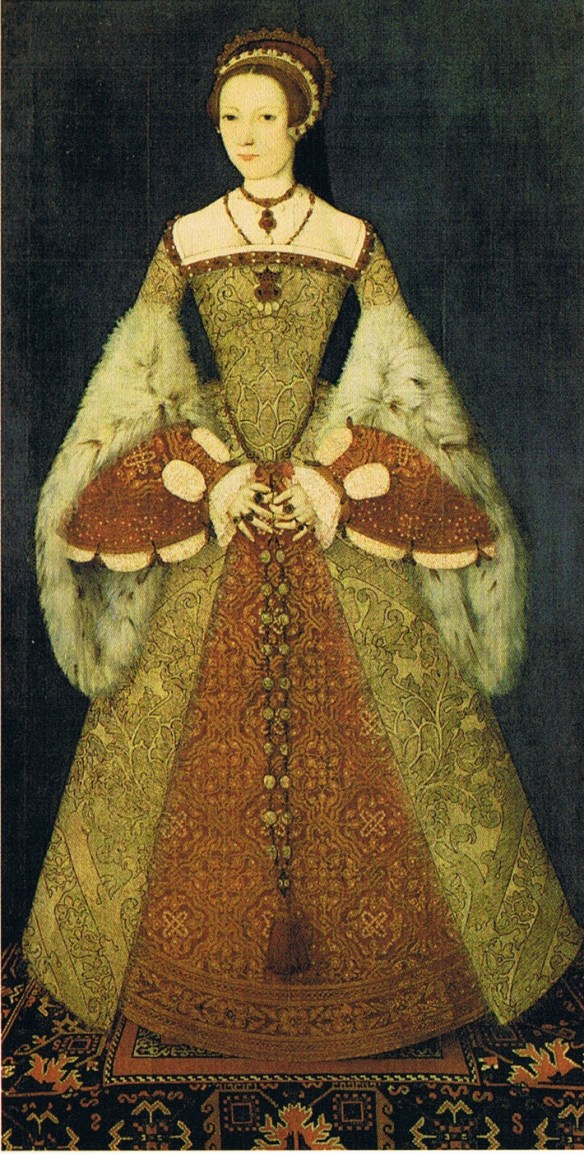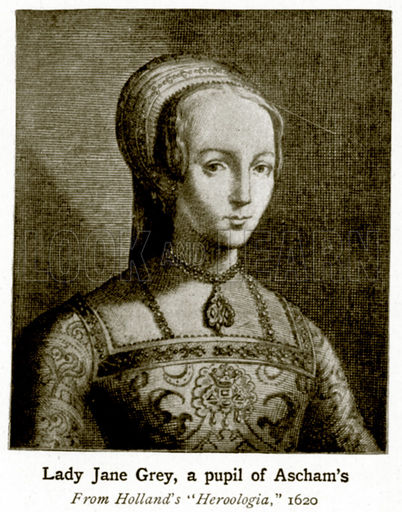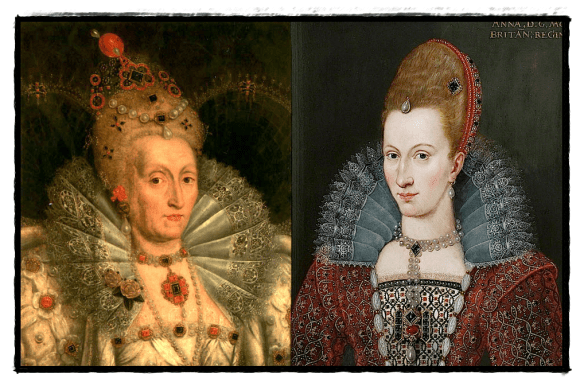In 1965, the National Portrait Gallery bought a portrait which was labeled “Katherine Parr.” In the late 60s however, one man came to the conclusion that it was not Parr, but “Lady Jane Grey,” the nine day queen who followed King Henry VIII’s only legitimate son, King Edward VI. Most people don’t even realize that the painting came in as “Katherine Parr.” In fact, unless you do thorough research you won’t even know that the portrait was originally at Glendon Hall, the seat of the Lane family. Glendon Hall once belonged to Sir Ralph Lane who married Hon. Maud Parr, a cousin and lady-in-waiting to Queen Katherine Parr. The portrait came to be generally accepted as Lady Jane for decades. The re-naming to “Lady Jane” was based on what you ask?
Seventy-two years after Kateryn Parr’s death
in September 1548, the bookseller Henry Holland published a
volume of plates purporting to be portraits of famous people, entitled
Henwologia Anglica. Holland asserts in the preface that he had
taken great pains to establish the identities of those in the portraits.
One of the plates shows a woman called ‘Iana Graya’ (Fig.28),
wearing the same crown-headed brooch as the sitter in our portrait;
a note on the plate indicates that the engraving was copied
‘from Mr James Harrison’s Holbein’. It was on the basis of the similarity
of the two brooches that Strong re-identified the panel portrait
as Jane Grey. However, Holland’s information in 1620 may
well have been incorrect, and nothing is known of Mr Harrison or
his ‘Holbein’ (which, on the evidence of the engraving would
appear to have been a variant of NPG 4451, quite close to the one
at Seaton Delaval). And the evidence of the jewellery indicates that
the crown-headed brooch did belong to Kateryn Parr and is most
unlikely to have passed through the hands of Jane Grey. (James)
Following research published in 1996 the identity of the sitter has been reassessed and the traditional identification of the sitter as “Katherine Parr” has been re-confirmed (James, 1996). Several of the jewels worn in the portrait can be traced to certain lists. James used several different inventories of jewels belonging to queens Katherine Howard (inventory as of 1542), ‘The Quene’s Jewells’ (inventory as of 1550), and a third undated list entitled “Inventory of jewels — parcel of the Queen’s Jewels and other stuff which came from the late Admiral’s [Thomas Seymour] house of Sudeley.” The 1542 list is of particular interest due to the fact that after Howard was arrested, her jewels were handed over to her lady-in-waiting, Lady Anne Herbert (sister of the future queen Katherine Parr). The list of 1550 was ordered by the Lord Protector as part of a comprehensive inventory of the ‘goods of Henry VIII.’ This list was entitled “The Quene’s Jewells.” Each list was looked at by James. The coronet shaped brooch was not found in the list for 1542. However, a similar one was described in the 1550 list and that of Parr’s possessions. The brooch may be identified with one described in the 1550 jewel list as,

Detail of the Coronet Brooch of Katherine Parr, NPG; © Susan James (black&white detail) © National Portrait Gallery (color detail)
‘one ouche or flower
with a crown containing two diamonds, one ruby, one emerald; the
crown being garnished with diamonds, [andl three pearls pendant’
(an ‘ouche’ or ‘flower’ was a brooch worn pinned to the bodice).
As for the brooch and what happened to it — it is believed the brooch was uniquely made for Katherine by her favorite goldsmith, Peter Richardson. The brooch, with the rest of the royal jewelery, was passed to Elizabeth I. The brooch appears in her list of 1587 listed as
‘a flower with a crown, garnished with xv small diamonds and in the midst of the flower is a ruby with two diamonds and one emerald, and the three pearls pendant.’
At Elizabeth’s death (1603), the brooch passed to James I’s queen, Anne of Denmark and is also described in her inventory of 1606 as
‘a jewell being a crownet of gold garnished with small diamonds upon a circle, having had one emerald, one rock ruby and two other triangle stones nowe wanting in collets, with three pearles pendant, of ancient making, in weight 2 oz 1dwt 6grs.’
A working copy of of the documentation kept in the jewel house describes the fate of the brooch. By 1606, the the brooch was missing two triangular cut diamonds. It was ordered to be
‘delivered to Mr. Nicasius Russell, Jeweler, the 8th September 1609 by her Majesties’ direction, for the making of Gold plate; the stones by number, the Gold by weight.’
The sixty-six year history of the brooch can be traced through the jewel inventories of three queens, Katherine Parr, Elizabeth I, and Anne of Denmark. Now, if only we could find a portrait of Elizabeth actually wearing the brooch!
Sources
- Susan E. James. “Lady Jane Grey or Queen Kateryn Parr?” The Burlington Magazine, Vol. 138, No. 1114 (Jan., 1996), pp. 20-24.





Pingback: Queen Katherine Parr: The Cameo Beads | tudorqueen6
What about the chain around her waist in the “Mater John” portrait? It intriguingly consists of cameos of heads. I wonder if it can be traced in inventories as well.
The coronet Brooch is from that painting.
Pingback: Portraits of Queen Katherine: Reason and Logic vs Opinion | tudorqueen6
Pingback: O Broche Coronet | O Diário de Ana Bolena